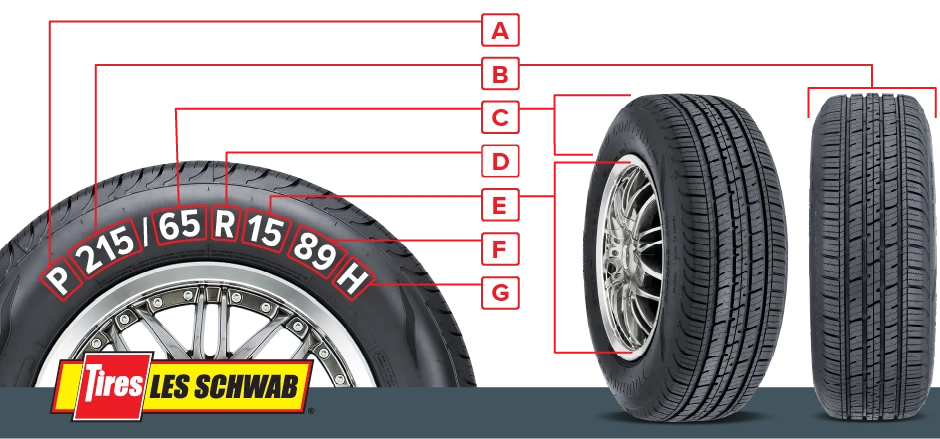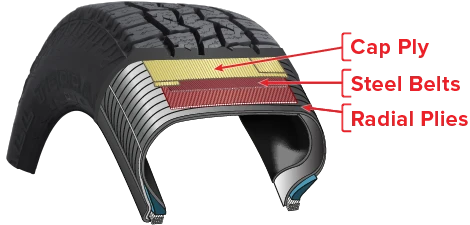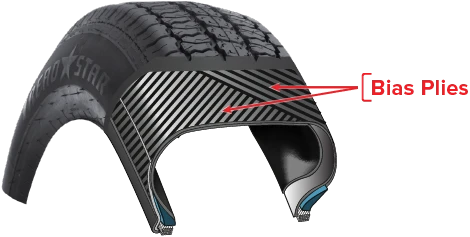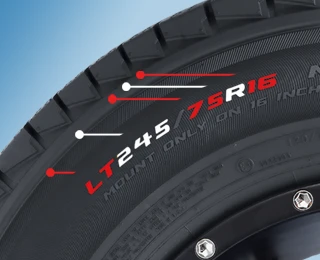Tire Size Explained: What Do The Numbers On The Side Of A Tire Mean?
Whether you’re switching out your tires for a different look or added performance, a good place to start your search for that new tread is the sidewall on one of your existing tires. The numbers and letters on that sidewall represent everything from the tire type and width to the aspect ratio, construction type, diameter, load index, and speed rating. Here’s how to read the sidewall on your tires.
Tire Size Meanings
The numbers and letters on the sidewall can be confusing. Here’s what each one means.

A: TIRE TYPE

The first letter in the code tells you what class of tire it is.
- P stands for passenger vehicle tire. P-class tires include cars, SUVs, crossovers, minivans and smaller pickup trucks, as well as EVs (electric vehicles). While the right load capacity can be achieved for electric vehicles with a standard passenger vehicle tire, special EV tires may be available for some vehicles. Look for the letters EV on the sidewall.
- LT means light truck tire, designed for vehicles capable of carrying heavy loads, towing trailers, or for those looking for an extra heavy-duty option. These are often equipped on three-quarter or 1-ton trucks and SUVs.
- ST stands for Special Trailer. These tire sizes are meant for trailers, including fifth wheels and other travel trailers, as well as boat and utility trailers.
If there’s no letter before the first number, you have a metric tire most commonly referred to as European size. It’s also measured in millimeters but may have a different load capacity than a P or LT tire. Confused by all the numbers and letters? The pros at Les Schwab can help.
B: TIRE WIDTH

The three-digit number following the letter is the tire’s width (from side to side, looking at the tire head-on) in millimeters. This may also be referred to as the section width.
C: ASPECT RATIO

The forward slash separates the tire width number from the two-digit aspect ratio. The bigger the aspect ratio, the higher/taller the tire’s sidewall, or “profile” as it’s sometimes called.
The aspect ratio is indicated on the tire sidewall as a percentage. It’s the height of the sidewall measured from wheel rim to top of the tread, expressed as a percentage of tire width.
In this example, the aspect ratio is 65, meaning the sidewall is 65 percent as high as the tire is wide. To get the sidewall height, take the tire width of 215 mm and convert it to inches (8.46). Then multiply this by 65% (.65). This gives you an answer of 5.5, the sidewall height in inches.
D: CONSTRUCTION TYPE

This single letter tells you about the internal construction of the tire. These include radial and bias.
R: Radial Tires

R is for radial tires, the industry standard for most tires today. They have better road grip, lower rolling resistance for better gas mileage or electric range, ride comfort and durability than previous generations of tires. In a radial tire, the plies — layers of strong cords made of a blend of polyester, steel and fabric and coated with rubber — are laid perpendicular to the direction of travel.
D: Diagonal Plies or Bias-Constructed Tires

D is for tires built with diagonal (crisscrossed) plies, called bias-constructed tires. They are also called conventional, x-ply, or cross-ply tires. Some motorcycle and trailer tires still use this internal construction.
E: WHEEL DIAMETER

This two-digit number specifies wheel diameter in inches. It’s the distance between the two bead seat areas (where a tire gets tightly sealed onto the wheel).
F: LOAD INDEX

The two-digit or three-digit number that follows the gap specifies tire load index.
The load index symbol indicates how much weight a tire can support, based on the following standard chart (see below). In our example, the load index is 89. This means the tire has a load capacity of 1,279 pounds, when inflated to the tire’s maximum air pressure rating.
Please note: Some run-flat tires are identified with an F followed by the type of internal construction.
G: SPEED RATING

The last letter is the tire speed rating.
This indicates the top speed it’s safe to travel for a sustained amount of time. A tire with a higher speed rating can handle heat better and provide more control at faster speeds. The maximum operating speed of a vehicle is no more than the lowest speed rating of all tires mounted on the vehicle. (Of course, you should always abide by speed limits for safer driving.) Speed rating is usually, but not always, a single letter (see the chart below).
Tire Size Charts
Below you will find several charts that will help you understand tire sizing numbers, including a load index chart and speed rating chart.
LOAD INDEX
| LOAD INDEX | LOAD (lbs) | LOAD INDEX | LOAD (lbs) | LOAD INDEX | LOAD (lbs) |
|---|---|---|---|---|---|
| 65 | 639 | 94 | 1477 | 123 | 3417 |
| 66 | 661 | 95 | 1521 | 124 | 3527 |
| 67 | 677 | 96 | 1565 | 125 | 3638 |
| 68 | 694 | 97 | 1609 | 126 | 3748 |
| 69 | 716 | 98 | 1653 | 127 | 3858 |
| 70 | 739 | 99 | 1709 | 128 | 3968 |
| 71 | 761 | 100 | 1764 | 129 | 4079 |
| 72 | 783 | 101 | 1819 | 130 | 4189 |
| 73 | 805 | 102 | 1874 | 131 | 4299 |
| 74 | 827 | 103 | 1929 | 132 | 4409 |
| 75 | 853 | 104 | 1984 | 133 | 4541 |
| 76 | 882 | 105 | 2039 | 134 | 4674 |
| 77 | 908 | 106 | 2094 | 135 | 4806 |
| 78 | 937 | 107 | 2149 | 136 | 4938 |
| 79 | 963 | 108 | 2205 | 137 | 5071 |
| 80 | 992 | 109 | 2271 | 138 | 5203 |
| 81 | 1019 | 110 | 2337 | 139 | 5357 |
| 82 | 1047 | 111 | 2403 | 140 | 5512 |
| 83 | 1074 | 112 | 2469 | 141 | 5677 |
| 84 | 1102 | 113 | 2535 | 142 | 5842 |
| 85 | 1135 | 114 | 2601 | 143 | 6008 |
| 86 | 1168 | 115 | 2679 | 144 | 6173 |
| 87 | 1201 | 116 | 2756 | 145 | 6393 |
| 88 | 1235 | 117 | 2833 | 146 | 6614 |
| 89 | 1279 | 118 | 2910 | 147 | 6779 |
| 90 | 1323 | 119 | 2998 | 148 | 6944 |
| 91 | 1356 | 120 | 3086 | 149 | 7165 |
| 92 | 1389 | 121 | 3197 | 150 | 7385 |
| 93 | 1433 | 122 | 3307 |
| LOAD INDEX | LOAD (lbs) |
|---|---|
| 65 | 639 |
| 66 | 661 |
| 67 | 677 |
| 68 | 694 |
| 69 | 716 |
| 70 | 739 |
| 71 | 761 |
| 72 | 783 |
| 73 | 805 |
| 74 | 827 |
| 75 | 853 |
| 76 | 882 |
| 77 | 908 |
| 78 | 937 |
| 79 | 963 |
| 80 | 992 |
| 81 | 1019 |
| 82 | 1047 |
| 83 | 1074 |
| 84 | 1102 |
| 85 | 1135 |
| 86 | 1168 |
| 87 | 1201 |
| 88 | 1235 |
| 89 | 1279 |
| 90 | 1323 |
| 91 | 1356 |
| 92 | 1389 |
| 93 | 1433 |
| 94 | 1477 |
| 95 | 1521 |
| 96 | 1565 |
| 97 | 1609 |
| 98 | 1653 |
| 99 | 1709 |
| 100 | 1764 |
| 101 | 1819 |
| 102 | 1874 |
| 103 | 1929 |
| 104 | 1984 |
| 105 | 2039 |
| 106 | 2094 |
| 107 | 2149 |
| 108 | 2205 |
| 109 | 2271 |
| 110 | 2337 |
| 111 | 2403 |
| 112 | 2469 |
| 113 | 2535 |
| 114 | 2601 |
| 115 | 2679 |
| 116 | 2756 |
| 117 | 2833 |
| 118 | 2910 |
| 119 | 2998 |
| 120 | 3086 |
| 121 | 3197 |
| 122 | 3307 |
| 123 | 3417 |
| 124 | 3527 |
| 125 | 3638 |
| 126 | 3748 |
| 127 | 3858 |
| 128 | 3968 |
| 129 | 4079 |
| 130 | 4189 |
| 131 | 4299 |
| 132 | 4409 |
| 133 | 4541 |
| 134 | 4674 |
| 135 | 4806 |
| 136 | 4938 |
| 137 | 5071 |
| 138 | 5203 |
| 139 | 5357 |
| 140 | 5512 |
| 141 | 5677 |
| 142 | 5842 |
| 143 | 6008 |
| 144 | 6173 |
| 145 | 6393 |
| 146 | 6614 |
| 147 | 6779 |
| 148 | 6944 |
| 149 | 7165 |
| 150 | 7385 |
SPEED RATING
| SPEED SYMBOL | SPEED (mph) | |
|---|---|---|
| A1 | 3 | |
| A2 | 6 | |
| A3 | 9 | |
| A4 | 12 | |
| A5 | 16 | |
| A6 | 19 | |
| A7 | 22 | |
| A8 | 25 | |
| B | 31 | |
| C | 37 | |
| D | 40 | |
| E | 43 | |
| F | 50 | |
| G | 56 | |
| J | 62 | |
| K | 68 | |
| L | 75 | |
| M | 81 | |
| N | 87 | |
| P | 93 | |
| Q | 99 | |
| R | 106 | |
| S | 112 | |
| T | 118 | |
| U | 124 | |
| H | 130 | |
| V | 149 | |
| ZR* | W | 168 |
| Y | 186 | |
| (Y) | Above 186 |
*For tires having a maximum speed capability above 149 mph, a ZR may appear in the size designation... above 186 mph, a ZR must appear in the size designation, including a Y speed symbol in brackets.
Buying New Wheels or Changing Your Tire Size?
A tire size calculator is a quick way to ensure a new set of tires will fit your car, SUV, sports car, light truck or crossover. But remember, this calculator is only an estimate. It’s important to stay within the sizing tolerances of your vehicle. Tires that are the wrong size could cause some pull in the steering wheel, rub against the suspension or body of your vehicle, reduce clearance on hills, or result in a stiffer or noisier ride.
If you’re considering mounting a different tire size on your vehicle, stop by Les Schwab. We’ll help you make the right choice about the tires and wheels for your vehicle’s suspension, gearing, and bodywork. See how new tires and rims will look on your car or truck. Start shopping now.

